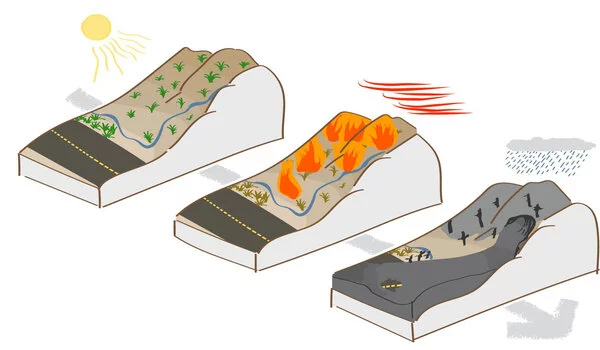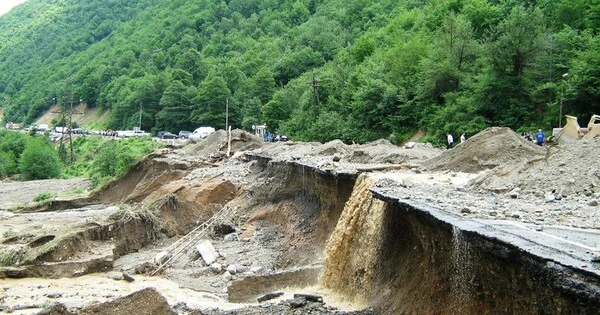Researchers have enhanced a physics-based numerical model to investigate and predict areas prone to debris flows. This enhanced model could eventually be used in an early warning system for people living in high-risk areas, allowing them to evacuate before it’s too late. Model simulation data could also be used to design new infrastructure for high-hazard zones, such as diversion bars that divert fast-moving water away from homes and roads.
A wildfire followed by a heavy rainstorm is often a recipe for disaster. Without vegetation to absorb rainfall, water runoff can transform into a fast-moving, highly destructive landslide known as a “debris flow,” capable of destroying cars, homes, and highways and sometimes resulting in fatalities.
Northwestern University researchers have enhanced a physics-based numerical model to investigate and predict debris flow risk areas. This enhanced model could eventually be used in an early warning system for residents of high-risk areas, allowing them to evacuate before it’s too late. Model simulation data could also be used to design new infrastructure for high-risk areas, such as diversion bars that divert fast-moving water away from homes and roads.
The research will be published in the journal Natural Hazards and Earth System Sciences.
“People want to know about their immediate and future risk,” said Daniel Horton, senior author of the study at Northwestern. “Although it is not yet operational, this modeling framework could one day be useful in forecasting where debris flows are likely to occur and determining who needs to be evacuated.”
One advantage of our model is that it uses precipitation in the real world. We’re simulating spatially complex and time-varying precipitation and how it interacts with the land surface. Our physics-based hydrological model expands our understanding of burn scar hydrology and debris flow susceptibility.
Daniel Horton
Horton is an assistant professor of Earth and planetary sciences in Northwestern’s Weinberg College of Arts and Sciences, where he also leads the Climate Change Research Group. Chuxuan Li, a Ph.D. candidate in Horton’s laboratory, is the paper’s first author.
Increasing debris flow ‘ingredients’
Debris flows may become more common as climate change increases the likelihood of wildfires and heavy rains. A debris flow ripped out a 150-foot section of Highway 1 near Big Sur, California, just last year. The scenic two-lane highway was closed for three months, effectively cutting off tourism to the region.
A wildfire that burned from August to December 2020, followed by an atmospheric river (a long, thin string of concentrated moisture in the sky) that dumped nearly a foot of rain the following January, caused the disaster.
Following intense rainfall, areas with wildfire burn scars are more susceptible to flash flooding. In a typical situation, vegetation interacts with rain, which then soaks into the ground. But if an area is burned, vegetation is gone, so it can no longer intercept the sudden influx of moisture. Even worse: In some regions, waxes from burned vegetation melts, enters the soil, and then solidifies. These waxes create a barrier for rain, blocking it from penetrating the soil. Instead, rain runs over the top of the soil, picking up rocks, mud, trees, and even cars to become a debris flow.
“Because of human-caused climate change, the ingredients that lead to debris flows are certainly becoming more common,” Horton said. “Due to intensified precipitation, drought and wildfires, debris flow conditions are particularly prevalent in California.”

Pinpointing susceptible areas
Horton’s team adapted the National Oceanic and Atmospheric Administration’s National Water Model, which is used to simulate streamflow and water resources across the continental United States, to create the new model.
“Because the National Water Model is a collaborative, open-source model, researchers use it to investigate a wide range of water resource and hazard issues,” Horton explained. “However, the model did not explicitly output overland flow, which is water that runs across the land after rainfall. We altered the model to examine how extreme precipitation moves across land surfaces, allowing us to investigate how vulnerable certain land surfaces, particularly burn scars, are to debris flow.”
By adjusting vegetation type (dense vs. barren, for example) and soil properties, the researchers were able to replicate how water moves over wildfire burn scars. The team then validated the model-simulated hydrological conditions using soil moisture and streamflow observations.
The resulting simulation found that burned areas cause water to flow much faster and in greater volumes compared to unburned land. When simulating the debris flow that took a bite out of Highway 1, for example, the researchers found overland flow volume increased eight-fold and peak flow tripled compared to land without burn scar characteristics.
“One advantage of our model is that it uses precipitation in the real world,” Horton explained. “We’re simulating spatially complex and time-varying precipitation and how it interacts with the land surface.”
“Our physics-based hydrological model expands our understanding of burn scar hydrology and debris flow susceptibility,” Li said. “With climate change increasing the likelihood of debris flow conditions, developing models to better understand past events and predict future events is critical.”





